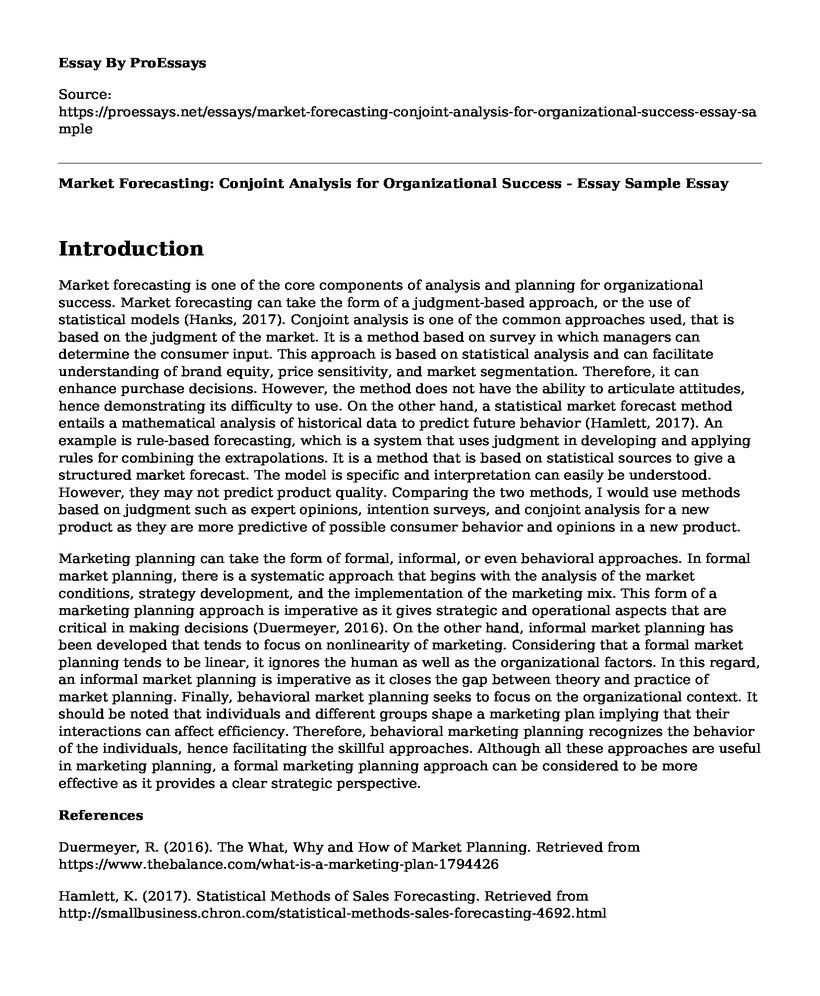Introduction
Market forecasting is one of the core components of analysis and planning for organizational success. Market forecasting can take the form of a judgment-based approach, or the use of statistical models (Hanks, 2017). Conjoint analysis is one of the common approaches used, that is based on the judgment of the market. It is a method based on survey in which managers can determine the consumer input. This approach is based on statistical analysis and can facilitate understanding of brand equity, price sensitivity, and market segmentation. Therefore, it can enhance purchase decisions. However, the method does not have the ability to articulate attitudes, hence demonstrating its difficulty to use. On the other hand, a statistical market forecast method entails a mathematical analysis of historical data to predict future behavior (Hamlett, 2017). An example is rule-based forecasting, which is a system that uses judgment in developing and applying rules for combining the extrapolations. It is a method that is based on statistical sources to give a structured market forecast. The model is specific and interpretation can easily be understood. However, they may not predict product quality. Comparing the two methods, I would use methods based on judgment such as expert opinions, intention surveys, and conjoint analysis for a new product as they are more predictive of possible consumer behavior and opinions in a new product.
Marketing planning can take the form of formal, informal, or even behavioral approaches. In formal market planning, there is a systematic approach that begins with the analysis of the market conditions, strategy development, and the implementation of the marketing mix. This form of a marketing planning approach is imperative as it gives strategic and operational aspects that are critical in making decisions (Duermeyer, 2016). On the other hand, informal market planning has been developed that tends to focus on nonlinearity of marketing. Considering that a formal market planning tends to be linear, it ignores the human as well as the organizational factors. In this regard, an informal market planning is imperative as it closes the gap between theory and practice of market planning. Finally, behavioral market planning seeks to focus on the organizational context. It should be noted that individuals and different groups shape a marketing plan implying that their interactions can affect efficiency. Therefore, behavioral marketing planning recognizes the behavior of the individuals, hence facilitating the skillful approaches. Although all these approaches are useful in marketing planning, a formal marketing planning approach can be considered to be more effective as it provides a clear strategic perspective.
References
Duermeyer, R. (2016). The What, Why and How of Market Planning. Retrieved from https://www.thebalance.com/what-is-a-marketing-plan-1794426
Hamlett, K. (2017). Statistical Methods of Sales Forecasting. Retrieved from http://smallbusiness.chron.com/statistical-methods-sales-forecasting-4692.html
Hanks, G. (2017). Judgment Based Methods for Forecasting. Retrieved from http://smallbusiness.chron.com/judgment-based-methods-sales-forecasting-74204.html
Cite this page
Market Forecasting: Conjoint Analysis for Organizational Success - Essay Sample. (2023, Feb 21). Retrieved from https://proessays.net/essays/market-forecasting-conjoint-analysis-for-organizational-success-essay-sample
If you are the original author of this essay and no longer wish to have it published on the ProEssays website, please click below to request its removal:
- Concepts of Identity in the Context of Consumer Behavior Essay
- Healthcare Quality Management Paper Example
- Essay Sample on Siemens' Company Strategy
- Leadership Challenges in Entrepreneurship Essay Example
- Accountable Care Organizations Model Paper Example
- Paper Example on 4 Rational Selling Premises for Strategic Communications
- Organizational Readiness for Change Theory: Cybercrime Risks in Transport Sector - Essay Sample







